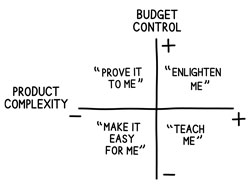|
Alex Goran : [in Miami, referring to Natalie's boyfriend] He broke up with you over text message?
Ryan Bingham : That's kind of like firing someone over the Internet.
(from "Up in the Air" 2009)

Among the hardest hit industries during this pandemic has been airline travel. The segment of air travel hit hardest is business travel. While less than 15% of travel, this segment is estimated to account for upwards of 40% of margin. The question is when will the business travel resume? Will it ever be the same?
I don't know what percentage of all business travel is sales related, but it has to be at least a third. Let's figure out how much of that will change. I have shared this grid with you before and it gives us a framework to explore how face-to-face sales comes back.

On the X is Product Complexity. This is from your prospect/customer's point of view. Do they know a lot about using and implementing your product or service? On the Y is your buyer/prospect's budget control. Does your buyer have the ability to re-allocate budget based on outcomes?
In general, the lower left quadrant is no longer done with face-to-face selling. It's marketing and ecommerce driven. If I have a set budget and know your product, make it easy for me to buy. Like buying a stapler. I know what it is, how it works, and if it fits my budget I'll buy it. The robots are taking over this kind of sale. Air travel is limited to reps getting products into aggregators at most.
The lower right is where a lot of Software as a Service (SaaS) companies live. In this quadrant face-to-face sales is giving way to marketing and remote selling presentations on the web versus ecommerce. Like buying a license for Adobe Creative Cloud. I have questions, I'd like to talk to someone. There is still a "fixed budget" issue keeping margins down and air travel is limited to conferences and trade shows.
The upper quadrants share the feature of working with buyers who have budget prioritization control. This may include decision committees and formal RFPs. When the product is perceived as simple, the buyer's question becomes "will it work in my unique situation?" Like an HR director buying employee reporting software. The outcome is understood. The question is about how it handles the complex nature of our organization with union members, management, highly compensated employees, etc. Air travel here is at risk because much of the evidence in proving your solution works can be done remotely.
The top right quadrant, however, will not see a drop in business air travel volume. It won't change because it's the executive level where strategic decisions are made. The opportunities tend to be larger, the implementation more complex, and the competition more fierce. The first time a rep relays a story about a competitor stealing an account because they had people in the prospect's building while she could only Zoom will result in her being put back on the plane.
The Prediction
What percentage of sales related business air travel is the top right quadrant? Good question. I'll say it's half. This half of sales related business class travel will come back by year-end, but the other half may be gone forever.
It's similar to how AI and machine learning are impacting sales. The lower level transactions are replaced first, the higher level decision functions replaced last, if ever.
Why "if ever?" The decisions are made at the top end and it's going to take a while before those humans decide to replace themselves with tech tools. If you're selling to this group, keep your luggage handy because you're still sitting in business class.
|